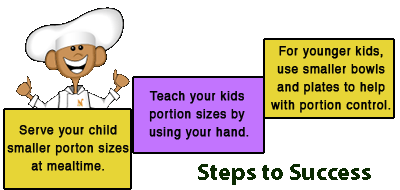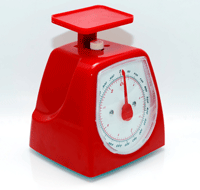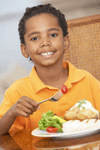Simple Steps To Controlling Portions Sizes At Home

Servings and portions sizes are confusing. These terms are often used interchangeably but actually they have different meanings.
But both terms are very important for children to understand and grown-ups too. Portions are the amount we choose to put on our plate. A serving is defined by the USDA as a specific amount of one food group. The amount your child puts on their plate may be larger or smaller than what the USDA My Plate has defined as one serving. And we know often times, the portion is much larger than one serving.

Most people underestimate what the amount they are actually putting on their plate. You could measure and weigh your food but that becomes quickly impractical. So how do you control portion sizes if you are not measuring everything?
You can teach your child to serve themselves smaller portions that are healthier and more in line with what a serving really is. As dietitians, we work with families on ways to help you and your children learn some practical methods to control portion sizes when snacking and eating meals at home.
Try these ideas to help control portions at home:
At Mealtime:
-
Use a salad plate for dinner. It is easier to control the amounts with a smaller plate.
-
Use small serving spoons or tablespoons to serve dishes
-
Let kids serve their own scoop. It gives them a little independence and helps them begin to realize serving sizes.
-
Include water as part of a healthy meal, its great for the digestion
-
Kids don’t have to eat all their food to have a healthy meal. Learning to listen to their internal hunger clock is part of learning proper portion control.
-
Don’t be tempted to finish off leftover dinner the next day. Freeze leftovers as single servings so that you can pull it out of the freezer when you need a quick, healthy meal for your family.
-
Include water as part of a healthy meal, its great for the digestion
-
Provide a nice variety of foods from each of the food groups.
-
Encourage your child to take one scoop from each of the food groups.
-
Have a couple vegetables and fruits to choose from. Even fresh and sliced is okay.
-
Kids like to dip. You can have some vegetables cut up and a low fat dressing.
-
Encourage kids to have fun coloring their plate with foods that have color. You’ll see that colorful foods tend to be the healthier foods.
-
Include one healthy carb from the grains food group. For example, serve just whole wheat bread, brown rice or whole wheat pasta instead of pasta and bread.
-
Cut lean meats into small portions before placing them on the table.
-
Avoid sodas, sugary drinks and fruit juices during meals. But if they insist on some juice, one six-ounce glass a day of 100% fruit juice is plenty.
During Snacktime
-
When your child is hungry and looking for a snack take the amount of food that is equal to one serving (refer to the Nutrition Facts label) and have your child eat it off a plate instead of eating it out of the box or bag.
-
Limit snacks to specific snack time so kids will be hungry during mealtime.
-
Have your child measure out a single serving of food before sitting in front of the television or doing other activities that can distract him/her from realizing how much food is being consumed. This way your child will know exactly how much he or she is eating!
-
Be prepared and have emergency snacks on hand if your family is running late and needs a quick snack. Make your own snack bags for traveling by reading the Nutrition Facts label and placing a single serving size into plastic bags.
Encourage your child to get familiar with the serving sizes because smart eating is an essential part of growing and staying healthy!
Healthy Eating

Healthy Child

Written by Michelle Mirizzi
•
Written on Oct 05, 2008
•
Last updated on Oct 15, 2013



0 Comments